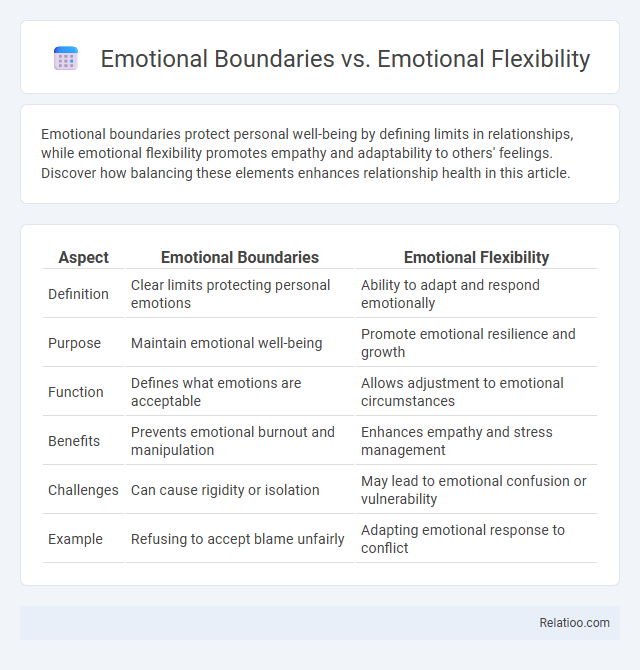Emotional boundaries protect personal well-being by defining limits in relationships, while emotional flexibility promotes empathy and adaptability to others' feelings. Discover how balancing these elements enhances relationship health in this article.
Table of Comparison
| Aspect | Emotional Boundaries | Emotional Flexibility |
|---|---|---|
| Definition | Clear limits protecting personal emotions | Ability to adapt and respond emotionally |
| Purpose | Maintain emotional well-being | Promote emotional resilience and growth |
| Function | Defines what emotions are acceptable | Allows adjustment to emotional circumstances |
| Benefits | Prevents emotional burnout and manipulation | Enhances empathy and stress management |
| Challenges | Can cause rigidity or isolation | May lead to emotional confusion or vulnerability |
| Example | Refusing to accept blame unfairly | Adapting emotional response to conflict |
Understanding Emotional Boundaries: Definition and Importance
Emotional boundaries define the limits you set to protect your emotional well-being, enabling you to recognize and respect your own feelings while preventing emotional exhaustion. Emotional flexibility involves adapting to changing emotional dynamics without compromising your core values or sense of self. Balancing emotional boundaries with flexibility is crucial for maintaining healthy relationships and fostering emotional resilience.
The Essence of Emotional Flexibility
Emotional flexibility is the ability to adapt your emotional responses to varying situations while maintaining healthy emotional boundaries that protect your well-being. Unlike rigid emotional boundaries, which may limit growth, and general flexibility, which refers to broader adaptability, emotional flexibility specifically involves recognizing and expressing emotions appropriately without losing control or compromising your values. This essence allows you to navigate complex social dynamics with resilience and empathy, fostering stronger relationships and personal growth.
Key Differences Between Emotional Boundaries and Flexibility
Emotional boundaries define personal limits for protecting one's feelings and maintaining self-respect, while emotional flexibility allows adapting to emotional situations without losing one's sense of self. Flexibility, in general, refers to the ability to adjust behavior or thinking in response to changing circumstances, which includes but is not limited to emotional responses. Key differences lie in emotional boundaries prioritizing self-protection and resilience, whereas emotional flexibility emphasizes openness and adaptability within those boundaries.
Benefits of Strong Emotional Boundaries
Strong emotional boundaries protect personal well-being by clearly defining limits in relationships, preventing emotional exhaustion and manipulation. They promote self-respect and healthier interpersonal dynamics by enabling individuals to distinguish their feelings from others' emotions. Balancing emotional flexibility with firm boundaries enhances resilience and adaptability without compromising mental health or personal values.
Advantages of Developing Emotional Flexibility
Developing emotional flexibility enhances your ability to adapt to changing emotional circumstances, improving resilience and reducing stress. This skill allows you to maintain healthy emotional boundaries while responding appropriately to others' feelings without becoming overwhelmed. Emotional flexibility supports better decision-making and fosters stronger interpersonal relationships by balancing stability with openness to new experiences.
Signs of Healthy Emotional Boundaries
Healthy emotional boundaries are marked by your ability to maintain a clear sense of self while respecting others' feelings, demonstrating emotional flexibility without losing personal integrity. Signs include the capacity to say no without guilt, the ability to express emotions appropriately, and the skill to disengage from toxic interactions. Emotional flexibility complements boundaries by allowing adaptability in relationships, but strong boundaries ensure your mental and emotional well-being remain protected.
Indicators of Emotional Flexibility in Relationships
Indicators of emotional flexibility in relationships include the ability to adapt to changing emotional dynamics, express feelings authentically without fear of judgment, and maintain empathy during conflicts. Individuals with high emotional flexibility navigate emotional boundaries effectively, balancing personal needs with their partner's feelings while allowing for mutual growth. This flexibility fosters resilience, enhances communication, and supports healthier, more connected partnerships.
Balancing Boundaries and Flexibility: Strategies for Success
Balancing emotional boundaries and flexibility involves recognizing personal limits while remaining open to change and empathy in relationships. Effective strategies include setting clear limits to protect mental well-being, practicing active listening to understand others' perspectives, and adapting responses without compromising core values. Developing this balance enhances emotional intelligence, fosters healthier interactions, and promotes resilience in dynamic social environments.
Common Challenges in Managing Emotions
Common challenges in managing emotions include distinguishing between emotional boundaries, which protect personal well-being by limiting emotional overreach, and emotional flexibility, the capacity to adapt feelings in response to changing situations. Maintaining emotional boundaries can be difficult when empathy blurs the lines between others' emotions and one's own, while excessive rigidity or lack of flexibility hampers emotional resilience. Balancing these aspects requires awareness of triggers and intentional regulation to prevent emotional exhaustion or detachment.
Practical Tips for Enhancing Boundaries and Flexibility
Emotional boundaries involve clearly defining personal limits to protect mental well-being, while emotional flexibility allows adapting to changing feelings without losing self-identity; practical tips include practicing assertive communication, regularly reflecting on emotional responses, and setting consequences for boundary violations. Enhancing flexibility requires mindfulness techniques, embracing uncertainty, and cultivating empathy to understand diverse perspectives. Balancing these skills improves relationship dynamics and fosters emotional resilience through consistent self-awareness and intentional boundary reinforcement.

Infographic: Emotional Boundaries vs Emotional Flexibility
 relatioo.com
relatioo.com